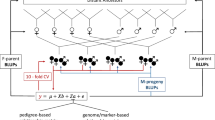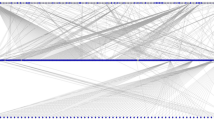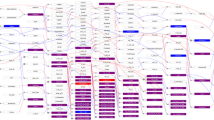Abstract
The strategy for breeding blueberries has been based on phenotypic selection without accounting for pedigree correlation information. A central premise of classical quantitative genetics is that through knowledge of the relationships among individuals in a population, we can make inferences about breeding values (BVs), estimate genetic parameters, and support phenotypic selection. Genetic evaluations using best linear unbiased prediction (BLUP) and restricted maximum likelihood (REML) are founded on pedigree information and have been the standard method used in livestock and forest breeding. Despite theoretical and practical benefits, their application in blueberry breeding programs remains unexploited. The objective of this study was to evaluate the use of REML/BLUP in the University of Florida blueberry breeding program in order to estimate genetic parameters and predict BVs of primary selection traits. To do this, we collected phenotypic data for eight selectable traits (yield, flower bud density, fruit weight, fruit firmness, fruit diameter, fruit soluble solids, fruit pH, and fruit scar diameter) from 1996 individuals. The highest narrow-sense heritabilities were found for fruit weight, scar diameter, and yield. The majority of genetic correlations between traits were under 0.20. The largest genetic gain was achieved when selections from early stages were used as parents and the top 5% of the population was selected. Compared to traditional phenotypic selection, our results are evidencing of the importance of implementing REML/BLUP to estimate genetic parameters that help and support the breeding strategy and maximize genetic gains.






Similar content being viewed by others
References
Aalders LE, Hall IV (1975) A study of variation in fruit yield and related characters in two diallels of the lowbush blueberry, Vaccinium angustifolium Ait. Can J Genet Cytol 17:401–404
Akaike H (1974) A new look at the statistical model identification. IEEE Trans Autom Control 19(6):716–723
Amadeu RR, Cellon C, Olmstead JW, Garcia AA, Resende MF, Muñoz PR (2016) AGHmatrix: R Package to construct relationship matrices for autotetraploid and diploid species: a blueberry example. Plant Genome. https://doi.org/10.3835/plantgenome2016.01.0009
Awad MA, De Jager A, Dekker M, Jongen WM (2001) Formation of flavonoids and chlorogenic acid in apples as affected by crop load. Sci Hortic 91:227–237
Ballinger WE, Kushman LJ, Brooks JF (1963) Influence of crop load and nitrogen applications upon yield and fruit qualities of Wolcott blueberries. Proc Am Soc Hort Sci 82:264–276
Ballington JR (1990) Germplasm resources available to meet future needs for blueberry cultivar improvement. Fruit Var J 44:54–62
Ballington JR, Ballinger WE, Swallow WH, Galletta GJ, Kushman LJ (1984) Fruit quality characterization of 11 Vaccinium species. J Am Soc Hort Sci 109:684–689
Bernardo R (1991) Correlation between testcross performance of lines at early and late selfing generations. Theor Appl Genet 82:17–21
Coville FV (1937) Improving the wild blueberry In: Yearbook of agriculture. The United States Department of Agriculture, Washington DC, pp 559–574
De Souza VA, Byrne DH, Taylor JF (1998a) Heritability, genetic and phenotypic correlations, and predicted selection response of quantitative traits in peach: I. An analysis of several reproductive traits. J Am Soc Hort Sci 123:598–603
De Souza VA, Byrne DH, Taylor JF (1998b) Heritability, genetic and phenotypic correlations, and predicted selection response of quantitative traits in peach: II. An analysis of several fruit traits. J Am Soc Hort Sci 123:604–611
Draper AD, Scott DH (1969) Fruit size inheritance in highbush blueberries, Vaccinium australe small. Proc Am Soc Hort Sci 94:417–418
Draper AD, Galletta GJ, Ballington JR (1982) Breeding methods for improving southern tetraploid blueberries. J Am Soc Hort Sci 107:106–109
Dufresne F, Stift M, Vergilino R, Mable BK (2014) Recent progress and challenges in population genetics of polyploid organisms: an overview of current state-of-the-art molecular and statistical tools. Mol Ecol 23(1):40–69
Edwards TW, Sherman WB, Sharpe RH (1974) Evaluation and inheritance of fruit color, size, scar, firmness and plant vigor in blueberry. HortScience 9:20–22
Ehlenfeld MK, Martin RB (2002) A survey of fruit firmness in highbush blueberry and species-introgressed blueberry cultivars. HortScience 37:386–389
Ehret DL, Frey B, Forge T, Helmer T, Bryla DR (2012) Effects of drip irrigation configuration and rate on yield and fruit quality of young highbush blueberry plants. HortScience 47:414–421
Erb WA, Draper AD, Galletta GJ, Swartz HJ (1990) Combining ability for plant and fruit traits of interspecific blueberry progenies on mineral soil. J Am Soc Hort Sci 115:1025–1028
Falconer DS (1960) Introduction to quantitative genetics. Ronald Press, New York
Finn CE, Luby JJ (1986) Inheritance of fruit development interval and fruit size in blueberry progenies. J Am Soc Hort Sci 111:784–788
Finn CE, Luby JJ (1992) Inheritance of fruit quality traits in blueberry. J Am Soc Hort Sci 117:617–621
Finn CE, Olmstead JW, Hancock JF, Brazelton DM (2014) Welcome to the party! Blueberry breeding mixes private and public with traditional and molecular to create a vibrant new cocktail. Int Symp Vaccinium Other Superfruits 1017:51–62
Gezan SA, Osorio LF, Verna S, Whitaker VM (2017) An experimental validation of genomic selection in octoploid strawberry. Hortic Res 4:16070
Gilbert JL, Guthart MJ, Gezan SA, De Carvalho MP, Schwieterman ML, Colquhoun TA, Olmstead JW (2015) Identifying breeding priorities for blueberry flavor using biochemical, sensory, and genotype by environment analyses. PLoS ONE 10:e0138494
Gilmour AR, Gogel BJ, Cullis BR, Thompson R (2014) ASReml user guide Release 4.0. VSN International Ltd, Hemel Hempstead
Henderson CR (1975) Best linear unbiased estimation and prediction under a selection model. Biometrics 31:423–447
Isik F, Holland J, Maltecca C (2017) Genetic data analysis for plant and animal breeding. Springer International Publishing, New York
Kelly AM, Cullis BR, Gilmour AR, Eccleston JA, Thompson R (2009) Estimation in a multiplicative mixed model involving a genetic relationship matrix. Genet Sel Evol 41(1):33
Kerr RJ, Li L, Tier B, Dutkowski GW, McRae TA (2012) Use of the numerator relationship matrix in genetic analysis of autopolyploid species. Theor Appl Genet 124:1271–1282
Kouassi AB, Durel CE, Costa F, Tartarini S, van de Weg E, Evans K, Fernandez-Fernandez F, Govan C, Boudichevskaja A, Dunemann F, Antofie A, Lateur M, Stankiewicz-Kosyl, Soska A, Tomala K (2009) Estimation of genetic parameters and prediction of breeding values for apple fruit-quality traits using pedigreed plant material in Europe. Tree Genet Genomes 5(4):659–672
Lannes SD, Finger FL, Schuelter AR, Casali VWD (2007) Growth and quality of Brazilian accessions of Capsicum chinense fruits. Sci Hortic 112(3):266–270
Lynch M, Walsh B (1998) Genetics and analysis of quantitative traits. Sinauer, Sunderland
Lyrene PM (1993) Some problems and opportunities in blueberry breeding. Int Symp Vaccinium Cul 346:63–71
Lyrene PM (2002) Development of highbush blueberry cultivars adapted to Florida. J Am Pomol Soc 56:79–85
Lyrene PM (2005) Breeding low-chill blueberries and peaches for subtropical areas. HortScience 40:1947–1949
Lyrene PM, Ballington JR (1986) Wide hybridization in Vaccinium. HortScience 21:52–57
Minamikawa MF, Nonaka K, Kaminuma E, Kajiya-Kanegae H, Onogi A, Goto S, Yoshioka T, Imai A, Hamada H, Hayashi T, Matsumoto S, Katayose Y, Toyoda A, Fujiyama A, Nakamura Y, Shimizu T, Iwata H (2017) Genome-wide association study and genomic prediction in citrus: potential of genomics-assisted breeding for fruit quality traits. Sci Rep 7:4721
Mrode RA (2014) Linear models for the prediction of animal breeding values. Cabi, Wallingford
Olmstead JW, Finn CE (2014) Breeding highbush blueberry cultivars adapted to machine harvest for the fresh market. HortTechnology 24:290–294
Piepho HP, Möhring J, Melchinger AE, Büchse A (2008) BLUP for phenotypic selection in plant breeding and cultivars testing. Euphytica 161:209–228
Saftner R, Polashock J, Ehlenfeldt M, Vinyard B (2008) Instrumental and sensory quality characteristics of blueberry fruit from twelve cultivars. Postharvest Biol Tecnol 49:19–26
Schindelin J, Arganda-Carreras I, Frise E, Kaynig V, Longair M, Pietzsch T, Cardona A (2012) Fiji: an open-source platform for biological-image analysis. Nat Methods 9:676–682
Schwarz G (1978) Estimating the dimension of a model. Ann Stat 6:461–464
Sharpe RH (1953) Horticultural development of Florida blueberries. Proc Fla State Hort Soc 66:188–190
Slater AT, Wilson GM, Cogan NO, Forster JW, Hayes BJ (2013) Improving the analysis of low heritability complex traits for enhanced genetic gain in potato. Theor Appl Genet 127:809–820
USDA (2015) Noncitrus fruits and nuts 2014 summary. National Agricultural Statistics Service http://usda.mannlib.cornell.edu/usda/nass/NoncFruiNu//2010s/2015/NoncFruiNu-07-17-2015.pdf. Accessed 23 Oct, 2015
Williamson JG, Lyrene PM (1995) Commerical blueberry production in Florida (SP179). University of Florida Cooperative Extension Service, Gainesville, FL
Wilson AJ, Reale D, Clements MN, Morrissey MM, Postma E, Walling CA et al (2010) An ecologist’s guide to the animal model. J Anim Ecol 79(1):13–26
Acknowledgements
This material is based upon work that is partially supported by the National Institute of Food and Agriculture, United States Department of Agriculture, under Award Number 2014-67013-22418 to PM, JO, and JE.
Author information
Authors and Affiliations
Corresponding author
Electronic supplementary material
Below is the link to the electronic supplementary material.
10681_2018_2165_MOESM1_ESM.tiff
Supplemental Fig. 1 Blueberry numerator relationship matrix (A-matrix) constructed assuming tetrasomic inheritance. Population consists of 124 full-sib families totaling 1996 individuals. The 124 families are represented with intercalated colors (black and gray) on the top of the heatmap. Supplementary material 1 (TIFF 58 kb)
Rights and permissions
About this article
Cite this article
Cellon, C., Amadeu, R.R., Olmstead, J.W. et al. Estimation of genetic parameters and prediction of breeding values in an autotetraploid blueberry breeding population with extensive pedigree data. Euphytica 214, 87 (2018). https://doi.org/10.1007/s10681-018-2165-8
Received:
Accepted:
Published:
DOI: https://doi.org/10.1007/s10681-018-2165-8




